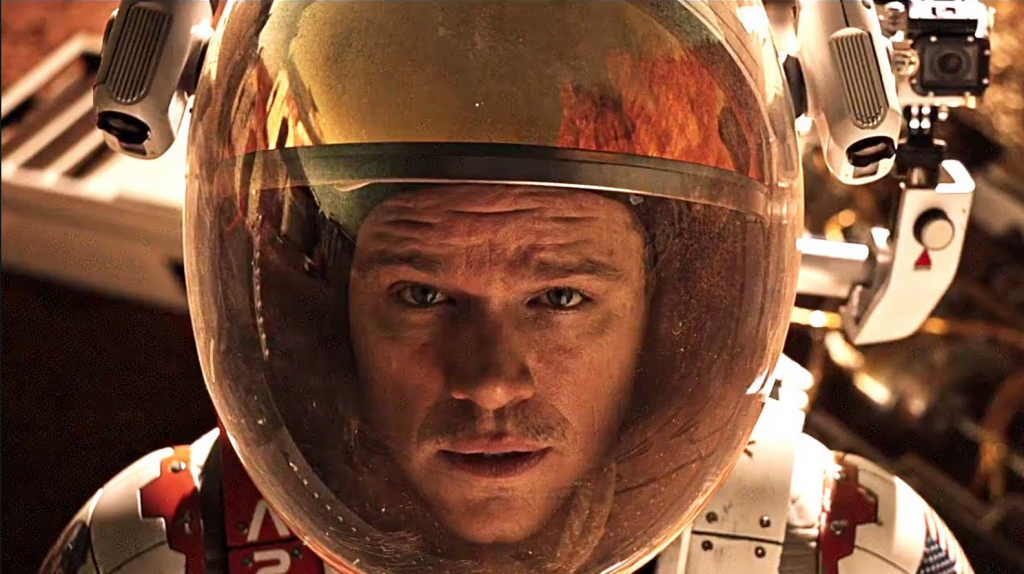FOD and I just returned from seeing The Martian, Ridley Scott’s film that adapts Any Weir’s novel of the same name to the big screen.
As you’ve come to expect from Airspeed, I won’t recap the film for you here, nor will I avoid spoilers. My only subjects are whether the film is worth seeing, whether it offends any scientific sensibilities, and – in this case – whether it faithfully follows the book.
Last things first. Why do I care so much about whether the film is faithful to the book? For starters, the book is one of those rare things in science fiction: A well-researched and skillfully rendered story that gets all the science right and requires only minimal suspension of disbelief. I’ve been through the book twice, both times in the form of the award-winning audiobook performance by R. C. Bray. I really, really enjoyed the book. Because of this, I walked into the theater with a large chip on my shoulder. It’s not impossible to think that Hollywood might treat The Martian with the disdain that it did with Robert A. Heinlein’s Starship Troopers.
I’m pleased to report that the film is very faithful to the book. There are minor differences. Venkat Kapoor becomes Vincent Kapoor, presumably so that Chiwetel Ejiofor (a Nigerian-born actor raised on London) could play the originally Indian character. The explosive loss of the airlock omits the part in which Watney pressurizes the lock and rolls it to where it needs to be. The final retrieval of Watney from the MAV capsule involves Watney breaching his suit and executing a very unlikely Iron-Man self-propulsion to rendezvous with Commander Lewis, who has inexplicably left the bridge to suit up and go get him (despite the fact that two other crew members are already suited up and likely closer to Watney).
I was actually happy about three differences. The film omitted the the event in which a short-circuit kills the Sojourner, as well as both the the roll-over accident involving the rovers and the dust storm on the drive to Schiaparelli Crater. Of those three, the dust storm was the only situation that produced an interesting solution, as opposed to brute force or lots of boring work to overcome. While all three events worked int he book, omitting them from the film made all kids of sense.
I liked that the film even kept many of the inside nerds-only jokes, such as the Lord of the Rings mention and the “steely-eyed missile man” reference. Movies need to quit worrying about whether a particular remark will go over the audience’s heads. Those who get the references will love you for including those elements. Those who don’t get the references probably won’t notice them anyway and – in any case – who the hell cares what non-nerds think, anyway?
If there were other material differences, I’ll admit that I didn’t notice them much. I consistently found myself remembering lines from the book as they were faithfully written or spoken on screen. I can’t think of another film that is as similar to its underlying book.
The science was pretty good. From depictions of orbital mechanics and rendezvous to the botanical representations, just about everything was convincing. I did see a few problems, though.
- The zero-G kickoff and multiple pulls to pick up speed as the crew moves around the spacecraft are unrealistic. When you pick up momentum, you have to get rid of it in one way or another. Experienced astronauts rarely build up that much momentum because they’re liable to break stuff or get hurt. I also saw several delta-vees (usually diving from a, axel tube into the spoke of a rotating section) that would have required thrusters to accomplish.
- Mars surface gravity is less than half that of Earth (3.7 m/s² on Mars vs. 9.8 m/s² for Earth). Yet all of the action on the surface of Mars appears to be in Earth-normal gravity. The atmosphere is less than 1% as dense as Earth’s atmosphere, which would have shown up in differences in the way the wind works and the effects on blown objects.
- The circular patch of the airlock frame looked suspiciously flimsy. (Am I the only guy who thought that all of the spare hab canvas looks exactly like faded visqueen?) And, in one scene, the wind makes the patch go concave into the hab. With the 13 or so psi that all of the readouts indicate, it would seem impossible that wind could push a patch to the point of concavity.
- FOD and I attended the film with fellow lawyer Don Crawford, who is also an active diver. Don sad that some things about the atmosphere and the readouts made little or no sense, but we didn’t have time adequate to discuss them.
The film never blew the transmission delay between Mars and Earth in an obvious way, but it wasn’t always clear that many minutes had passed between transmission and receipt. Maybe this is brilliant, inasmuch as it lets the conversation happen in near-realtime for moviegoers who aren’t aware of the physics, but is always plausibly there for moviegoers who know about the delay.
Bottom line: The film is very much worth seeing. In fact, I might try to get out to see it one more time while it’s in theatrical release, It’s that compelling and that pretty. I think it’s going to be regarded as one of the best of the year.

